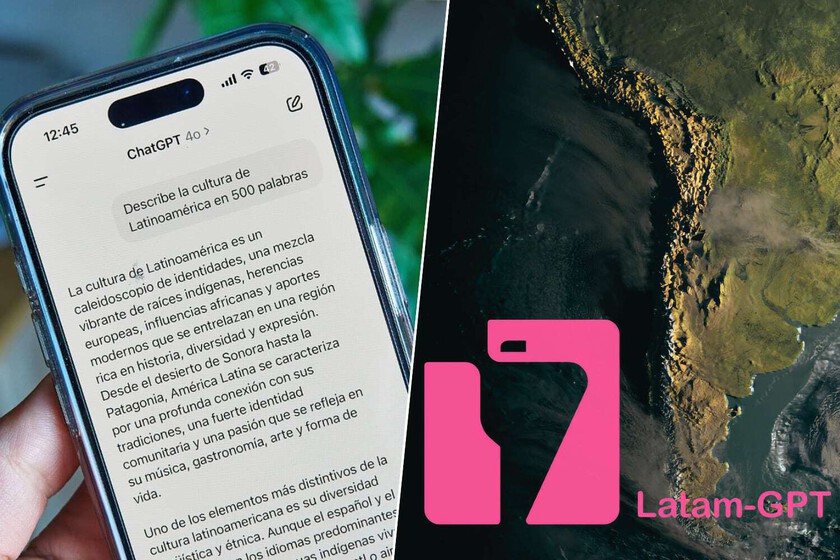Observing the development of the generative AI is most curious. In the United States they are great technological, and startups such as OpenAi, which have marked the rhythm. In China, companies are also developing their models, but the government has a particular interest in pushing this technological technology, of course, but also social and doctors. And now Latin America has joined to create its own chatgpt.
It will be called Latam-GPT and the motivation to create this model is curious: a Chilean center did not convince a chatgpt response on Latin American culture.
The question. “Describe Latin American culture in 500 characters.” That was, as we read in BBC, the request of some researchers from the National Artificial Intelligence Center -Cenia- from Chile to Chatgpt. His answer was the following:
“Latin American culture is a vibrant amalgam of indigenous roots, African influences and European heritage. It is characterized by its rich diversity in music, dance and gastronomy, reflected in festivals such as carnival and the Flower Fair. Its art, from muralism to literature, shows a deep connection with the history and local identity. The warmth, the sense of community and the celebration of community. pillars that enrich this dynamic and diverse culture. ”
I have to say that I just asked for it and the answer is different, but pivot over the same points, such as the fusion of indigenous, African and European inheritances, the taste for music and dance, colorful gastronomy and traditions such as carnival to give rise to a colorful cultural mosaic.
Latam-GPT. This response did not satisfy CENIA researchers, who considered that, although it is a high quality LLM, “their understanding of the Latin American context could be enriched and perfected.” Come on, they are convinced that the answer, although correct in broad strokes, needs to qualify a lot to better reflect the peculiarities of the culture of each Latin American country because Chatgpt gave an answer too … Generalist.
And that response for the region user will be LATAM-GPT. The intention is that it is a language model of and for Latin America and the Caribbean. The desire is that it addresses the common problems that language models have when interpreting idioms, cultural references and typical expressions of the Latin American context. Álvaro Soto, director of Cenia, states that US models hallucinate because Latin American data with which they have been trained are very scarce.
“We do not seek to compete with Openai or one of the giants. We want an own model of Latin America and the Caribbean, with the cultural requirements and challenges that implies” – Cenia
Goals. It is triple. On the one hand, what we have just mentioned: that it has a greater context when addressing issues related to the culture of each of the Latin American countries. On the other, that is open and public, allowing each developer to adapt applications to local needs in areas such as education, politics, economy or the environment.
Finally, perhaps the most important for something that countries in the region are looking for: stop depending on foreign models and technologies. Mexico, for example, has put on the table the intention of carrying out different projects within a large umbrella called Mexico Plan that seeks to enhance the sovereignty of the nation in several subjects, being technological – with its own industry of semiconductors or electric vehicles – one of its legs.

Financing. With Latam-GPT, it also seeks to promote technological innovation of the region thanks to a tool that can help others seek to develop their potential. But of course, carrying out something like that requires money, and it is something that is not going to stay only in Cenia. Chile has postulated as the leader of the project, but countries such as Mexico, Argentina, Colombia, Peru, Uruguay, Costa Rica or Ecuador have not taken long to join. There are also Spanish and American institutions on this ship.
It has financial support from associations and academic institutions of these countries, but there is also government support to develop this artificial intelligence.


Several countries are immersed in Latam-GPT
Funds. For training, researchers will use the infrastructure of the University of Tarapacá, in Chile. It will use a super -tank to train the model with more than 8 TB of data collected from public and private libraries. That training will take about 40 days and it is expected that, for summer of this 2025, LATAM-GPT can be accessed. Investment in infrastructure will be about 10 million dollars.
Now, one of the problems can be the consumption of the training center. We have already seen in Spain that not everyone looks good at the installation of data centers to train AI due to high consumption of water and energy, but from CENIA they expose that consumption in the first of the two stages will be 135 kWh.
The University of Tarapacá is located in Arica, in northern Chile, where there is a large energy matrix composed of renewables and the idea is to ‘throw’ them to supply electricity. In addition, from the agency they comment that “the cooling system – of the servers – will not generate water consumption due to the availability of cheap and abundant energy in Arica. CO₂ emissions associated with training will be 0.96 tons.”
Necessary? This would be, if the accounts are correct, that the training of this LLM will be more ecological than that of Google or OpenAi models, but there are some challenges ahead. One has to do with the protection of data they use to train the model. The researchers affirm that the main policy for the shelter of intellectual property will be transparency, with open sources that comply with the copyright laws and, at the same time, carry out automatisms of anonymity of personal data.
On the other hand, there are those who ask that all this … for what. Ulysses Mejías, of Mexican origin, is a professor at the State University of New York and has told BBC Mundo that, although it is the most “great, ambitious and best funded proposal that he has seen in Latin America, he does not trust the projects that try to differentiate themselves from those of the US and China without questioning the basic premise of those models.
“Does the Latam-GPT project try to provide a new answer to the question of what Genai is for? Or does it leave without questioning the assumption that general artificial intelligence basically serves to reduce labor costs and maximize business profits?”

Nvidia always wins. As much as it may be, and despite the issues and doubts of people such as Mejías, it is a matter of months that we see, if everything goes as planned, this LATAM-GPT. And what is clear is that, as much as they want to change things or stop depending on foreign technologies, there is still a single name in the West (in China we already know that Huawei is in the equation) protagonist when it comes to artificial intelligence: Nvidia.
The reason is that the data center will be equipped with 12 nodes with eight NVIDIA H200 GPU each. It is what they have calculated that it will be necessary to train the model with 50 billion parameters, comparable to GPT-3.5, and they have already advanced that it will be a first version that will be strengthened with “continuous improvements as more institutions are added and new data is integrated to perfect the model”.
We will have to have an eye on LATAM-GPT, but not only to that first version, but to its evolution. How adapting is what will mark the success or failure of the model.
In WorldOfSoftware | The United States and Europe face inevitability: sooner or later China will be the world chips leader












